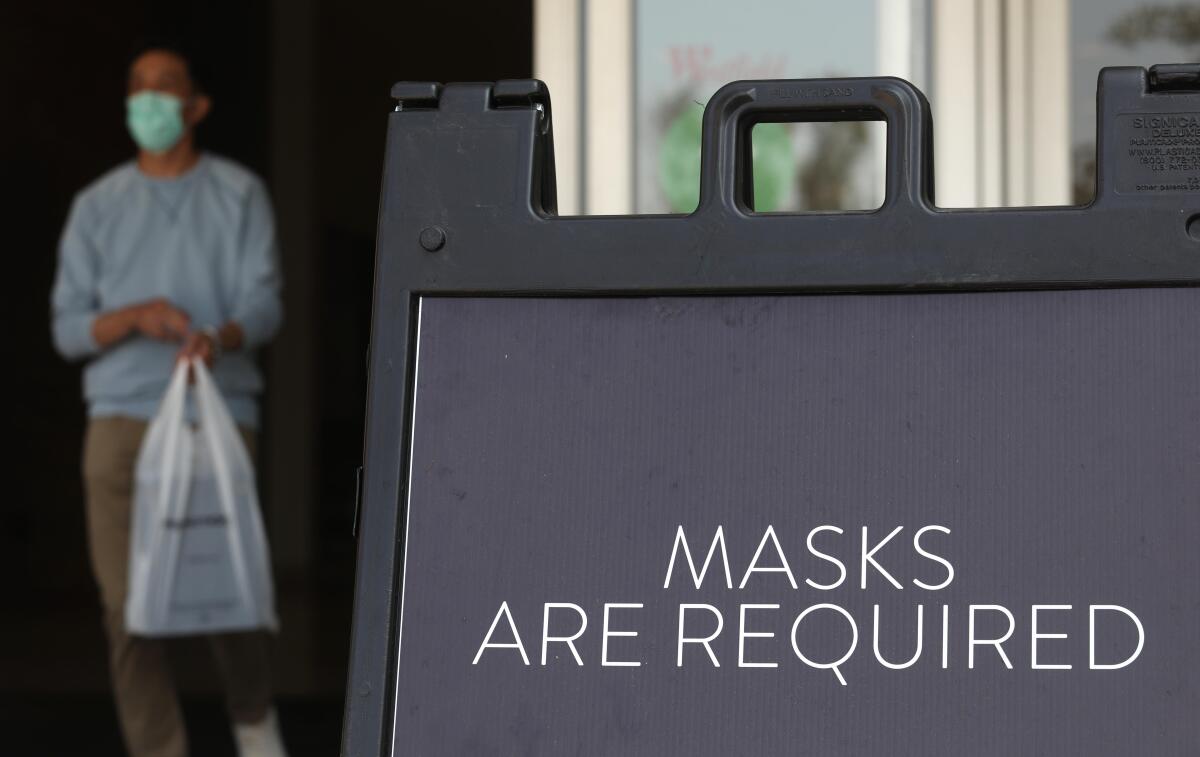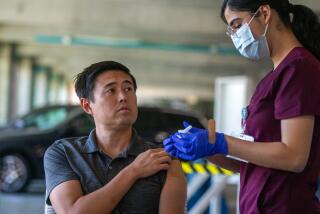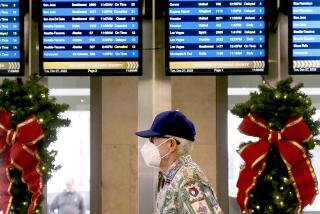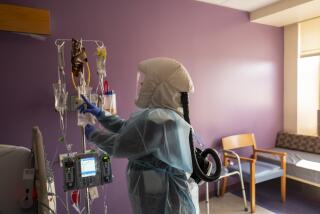Coronavirus transmission rate grows in L.A. County

- Share via
The novel coronavirus is spreading faster in Los Angeles County, with the rate of new cases expected to increase in the coming weeks, officials said Wednesday.
The uptick comes as Los Angeles and other counties have been reopening the economy over the last few weeks. Officials have been hoping to avoid a repeat of the COVID-19 surge that occurred over the summer, which forced officials to impose new restrictions on businesses and public spaces.
As more businesses have reopened in L.A. County over the last two weeks, Public Health Director Barbara Ferrer said Wednesday that the increase in infections has been connected largely to worksite outbreaks, defined as a cluster of three or more cases.
There have been 39 reported worksite outbreaks in the county from Sept. 20 through Oct. 4 — a 70% jump from the 23 outbreaks reported in previous weeks.
“This is a cause for concern, and we’ll continue to be monitoring what’s happening at workplaces,” Ferrer said.
Although most businesses have complied with COVID-19 safety protocols, Ferrer said the county has issued more than 130 citations, mostly to fitness centers and places of worship.
Large gatherings have also contributed greatly to infection increases, which is one reason that with Halloween less than three weeks away, Los Angeles Mayor Eric Garcetti asked residents to be creative in their celebrations and to avoid trick-or-treating.
“Door-to-door trick-or-treating is not recommended as it makes social distancing nearly impossible,” Garcetti said at his Wednesday media briefing. “And the same goes for what’s called trunk-or-treating where children go from car to car instead of from house to house, since it’s difficult to avoid that very same crowding.”
The recommendation came a day after the Beverly Hills City Council banned both varieties of candy grabs on Oct. 31.
Garcetti added that large Halloween parties, festivals, live entertainment and haunted house attractions were prohibited, adding: “Believe me, as a father I know how disappointing this is for our children.” He suggested coming up with new traditions, such as a Halloween version of an Easter egg hunt.
Private gatherings had been prohibited by state rules. Last week, state officials loosened those restrictions, allowing private parties that are outdoors and include no more than three households. Ferrer said the county would adopt the state guidelines while acknowledging that they were a “slippery slope” and that private gatherings should occur sparingly.
“It was meant to address the limited number of times people may need to gather,” she said, adding that regularly mixing with a broad spectrum of people is ill-advised.
Large gatherings remain prohibited under state orders, except for outdoor protests and outdoor worship services.
Overall, the county’s projected COVID-19 transmission rate has crept past 1 to 1.05, according to new modeling from L.A. County Health Services. A rate of 1 means that an individual with COVID-19 infects an average of one other person. Beyond 1, new cases would be expected to increase. Three weeks ago, the transmission rate had been greater than 1 before dipping lower. The downward trend is reversing, with officials estimating that 1 in 650 residents is now infected with the virus, versus 1 in 950 last week.
Likewise, the daily tally of new cases has been on the rise, though that could be because of a counting backlog. The number dropped in recent days to below 1,000 before rising to 1,349 new infections Wednesday.
“It is more likely that the number of cases will go up than they will go down,” Dr. Christina Ghaly, health services director, said at a news briefing Wednesday.
The projected transmission figures are especially crucial for health officials trying to make sure there are enough hospital beds.
There are 720 hospitalized COVID-19 patients in the county, with 27% of them in intensive care — notably lower than July’s peak of more than 2,000.
But hospitalization is a lagging indicator because it takes time for people to become seriously ill after being infected. As transmission increases, the need for hospital beds eventually will too.
The state recorded its lowest hospitalization count in six months Monday. But a statewide surge is forecast for the next few weeks, including in L.A. County, as some newly infected patients get sicker.
Statewide, the number of new cases was 4,383 on Tuesday — the highest since Sept. 25, when 4,122 cases were recorded, according to an analysis of data from the Los Angeles Times’ daily coronavirus tracker. Those trends could also be affected by delays in counting.
A summer-long surge after Memorial Day was followed by a significant decline. Recently, there have been slight upticks in some parts of the state.
Shasta County, which recently regressed to a lower tier on the state’s reopening matrix, recorded 254 cases Tuesday. Similarly, Riverside County recorded 729 cases and is in danger of moving back a tier.
California’s daily case count is still much lower than during the summer, when tens of thousands of new infections were reported on many days.
Statewide, the seven-day average for positive coronavirus cases is 3.4% — a significant drop from previous months. But in this pandemic, progress has sometimes been fleeting.
As more counties move to a less-restrictive tier, allowing more businesses to reopen, people may become more active and cause a resurgence.
“There’s no reason to think there’s not ongoing transmission,” said Dr. George Rutherford, an epidemiologist and infectious disease expert at UC San Francisco.
California has fared well in recent weeks compared with other states that are inching closer to a new coronavirus wave, due in large part to widespread reopenings at college campuses. But officials warn residents to remain vigilant.
“This is not the time to be complacent,” Ferrer said.
Times staff writers Iris Lee and Andrew J. Campa contributed to this report.
More to Read
Sign up for Essential California
The most important California stories and recommendations in your inbox every morning.
You may occasionally receive promotional content from the Los Angeles Times.














